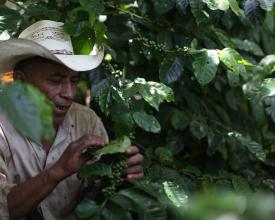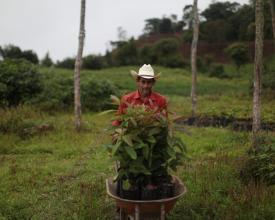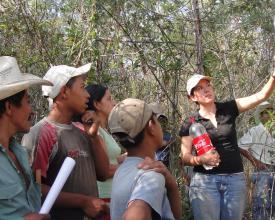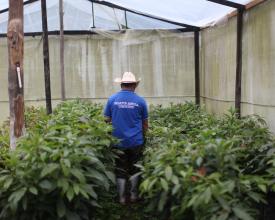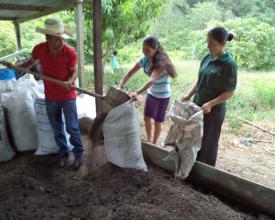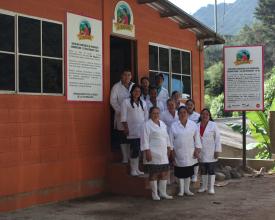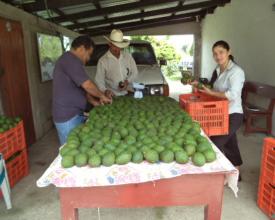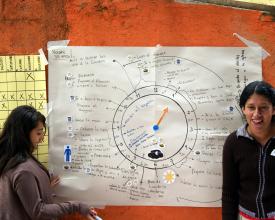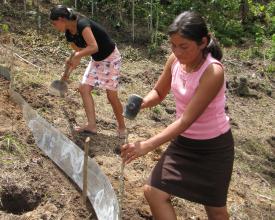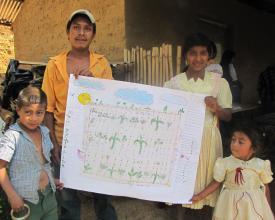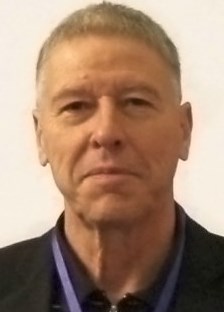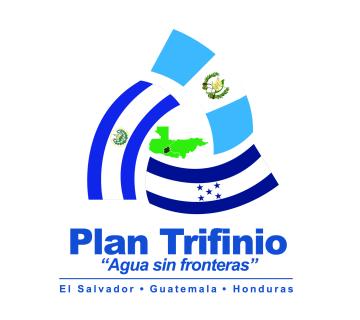
Cultivation of fruit trees and coffee in agroforestry systems with agroecological practices to improve water recharge in the Trifinio Region.
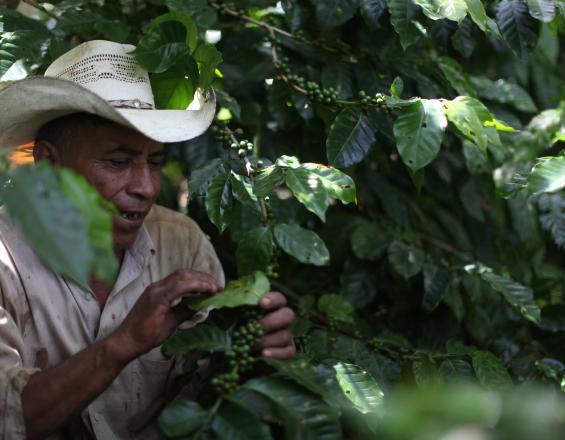
The Trifinio Region is bordered by 3 large watersheds that provide vital ecosystem services to El Salvador, Guatemala and Honduras. The Lempa River basin, for example, is key to the water supply of the capital of El Salvador. In order to improve water recharge in the Trifinio Region, a change in land use was promoted and accompanied by small farmers of scarce resources, who until then had been living from subsistence agriculture with low yields and little sustainability. They were encouraged to try out the cultivation of fruit trees in pilot plots, applying soil conservation practices. The solution proved to significantly improve water infiltration into the soil. It also strengthened the social fabric in the pilot micro-watersheds by promoting exchanges between the inhabitants and external stakeholders (governmental, non-governmental, private sector). In addition, market access capacities were strengthened, which improved family incomes.
Context
Challenges addressed
Environmental challenges
- Agricultural practices that are harmful to the environment and limit water infiltration into soils: burning, hillside cultivation without practices to prevent runoff, poor management of pesticides and toxic fertilizers, mainly crops that do not permanently cover the soil.
- Notorious contamination with chemicals in watercourses.
- Pressure on the forest, especially in areas adjacent to protected natural areas.
Social challenges
- Distrust of technicians, the new crop and disbelief in the economic benefits of the investment.
- Deeply rooted gender roles: women assume reproductive activities and men productive activities.
- Beneficiary population with minimal formal education
- Almost no government support institutions
Economic challenges
- Isolated communities with difficult access to lucrative markets, both physically and due to social and information barriers.
- Suspicion of organized sales
Location
Process
Summary of the process
Technical capacity building was the foundation of the solution. To ensure capacity building in a wide range of topics related to and complementary to crops, alliances were established and synergies were exploited with local stakeholders. In addition, small producers were assisted in establishing cooperative or commercial relationships with relevant actors. The linking of the producer groups with various entities in the territory and beyond contributed to the "desailarlas", with the vision of making the new environmentally friendly livelihood more sustainable over time. Likewise, the gender approach aimed to contribute to the sustainability over time of the changes promoted by the solution. The gender equity strategy with its 4 work axes was transversal to all activities. By facilitating equal access of men and women to knowledge and resources, the new agricultural practices found greater application, and living conditions in the communities were more profoundly transformed.
Building Blocks
Development of technical capabilities
The development of technical capacities with small producers for the establishment and management of agroforestry systems was carried out by coupling knowledge transfer with practical application by each producer in his pilot plot. The application of the practices was supported and accompanied by seed capital for each farmer. In farmer field schools, the technician taught theoretical and practical modules in a language suitable for all participants. He also promoted the exchange of knowledge among producers. For certain topics - gender equity, post-harvest management, etc. - specialized experts intervened. - specialized experts intervened. At the same time, the technician regularly visited the farmer in his pilot plot, thus creating space and trust for specific questions, and allowing the correction of wrong implementations. In order to maintain motivation in the group and encourage peer-to-peer exchange, several experience-sharing tours were organized to the countries of the Trifinio Region. Particularly empowered producers participated in training to become community agricultural promoters. These producers are now acting as technical assistants in their communities, and are disseminating good agricultural practices on a larger scale.
Enabling factors
- Motivated technicians, strongly supported by their manager, who established a transparent and trusting relationship with the communities.
- Community leaders willing to set an example and support change.
- Involvement of the whole family in the trainings
- Reasonable duration of the capacity building process, which allowed us to face together (technician-producers) doubts and setbacks. Here there were 8 years of technical assistance.
- Seed capital to establish pilot plots, since it requires a significant initial investment.
Lesson learned
- The generation of soil data with the active participation of low-income communities with a low level of formal education was possible, and had positive effects on their self-esteem and awareness of environmental issues.
- From the beginning, it was important to consider mechanisms for dissemination, replication and anchoring of knowledge in order to ensure the permanence of knowledge and a scaling up of its application in the territory (e.g., community agricultural promoters).
- Tri-national experience exchange tours in the Trifinio fostered direct dialogue among peers, giving participants confidence in their ability to undertake change.
- The transparent and participatory definition of framework conditions, such as maximum pilot area per farmer, investment required and support provided, required special care. Agreements with each farmer were recorded in a farm plan to avoid misunderstandings.
Articulation and linkage with stakeholders in the territory.
The communities in which the establishment of agroforestry systems was promoted and accompanied are isolated: they lack institutional presence and are difficult to access. In order to make the agroforestry systems and the use of agroecological practices more sustainable over time, the communities were included in a support network. By linking up with governmental, non-governmental and private sector actors, the small producers were able to further develop their agroforestry systems and their harvesting, processing and sales capacities. Initially, links with the various stakeholders were encouraged and actively accompanied by technical assistance. Progressively, interest in these isolated communities grew, and the small producers themselves also sought links. In this way, important support was obtained as contacts for the beneficiary small producers. A women's cooperative organized for peach processing, for example, obtained important investments in its processing infrastructure. Another example is the linkage of small coffee growers in Guatemala with the national coffee association, which provides them with regular training.
Enabling factors
- Concrete purpose in linking producers and stakeholders in the territory.
- Presence of actors willing to expand their area of intervention.
- Openness and willingness of technicians, experts and managers to coordinate activities.
Lesson learned
- The establishment of trusting relationships through the fulfillment of agreements and the development of a shared understanding was key to the successful exploitation of synergies.
- The implementation of concrete activities with specific short-term results promoted greater commitment in establishing cooperative relationships.
Gender equity approach
In order to have a more accurate picture of the situation in the communities where land use change to agroforestry systems was considered, a participatory analysis was carried out with the families. The analysis showed that women were mainly responsible for reproductive activities (taking care of the household, children and people in need). Men were in charge of productive activities (crops, resource management). Based on what was observed, four areas of work were defined to make the solution more sustainable:
- Sensitization of technical personnel involved in the solution as well as strategic partners to gender issues and measures to promote equal access to knowledge and resources;
- Sensitization and reflection in the communities on gender patterns;
- Definition of quotas for women among beneficiaries; and
- Implementation of affirmative measures and flexibility to facilitate women's access, such as definition of family farm plans, adaptable schedules and locations, encouragement of women's participation in management positions, flexibility in terms of accompanying children or partners to events, strengthening women's groups organized around crops.
Enabling factors
- Commitment and growing understanding, not only by a specialized expert, but by all those involved in gender equity issues.
- Sensitization and reflection methodologies, rather than coercive measures (e.g. through role-reflection workshops with producers and their partner)
- Gender-sensitive monitoring that verifies the effects of efforts to reduce the gender gap
- Willingness to and actual allocation of funds to ensure implementation of a gender approach
Lesson learned
- By encouraging women's participation in knowledge transfer activities and facilitating their access to resources, greater acceptance and implementation of environmentally friendly agricultural practices was observed.
- The strengthening of self-esteem was a progressive process. Motivation and encouragement to excel and try new things, as well as an openness to dialogue on the part of the technician were important.
- Reflection of gender patterns in the communities was an important step towards greater acceptance of change in them.
Impacts
- In 5 years of shade coffee cultivation, soil erosion was reduced by 45%, and water infiltration increased by 14%, when compared to land under corn and beans. Similar impacts were measured when comparing plots with natural grass and fruit trees.
- After 4 years of shade coffee cultivation, the average annual income of smallholders increased by 360% compared to the baseline (income from corn sales). In the case of avocado cultivation, the reported increase was 94% (compared to income from vegetable sales), and with peaches 49% (compared to income from corn sales). By organizing or joining marketing organizations, producers are also earning additional income of 13% on average, compared to producers selling individually.
- Of the pilot producers, 48 (a quarter women) were trained in knowledge dissemination. These community extensionists lead their own farmer field schools in the micro-watersheds, reaching almost 500 smallholders.
- Overall, a significant change in the self-esteem of the farmers and their families was observed, as well as a greater awareness of the impact of their actions on the environment.
Beneficiaries
499 smallholder farmers and their families in areas adjacent to water-loaded zones.
Overall, their level of education is primary school. The farmers own their land, which on average is 0.9 hectares in size.
Sustainable Development Goals
Story
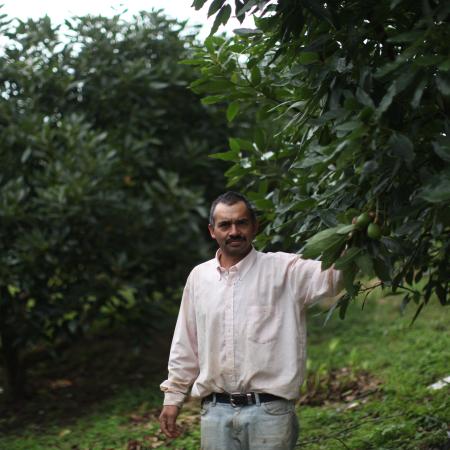
"We have to be clear and say that we were afraid of growing avocado. They gave us the opportunity to enter with half an manzana; some of us planted half an manzana [0.35 ha], others a quarter [0.17 ha]. Now we are organized and we have nurseries to expand the areas, after three years of harvesting and eight years of having started with the crop."
Edgar López is a small vegetable and avocado producer in the buffer zone of the El Güisayote Biological Reserve in western Honduras, part of the Trifinio tri-national region. With 25 other farmers from his community, he shared his doubts about the introduction of avocado cultivation with live fences and agroecological practices on his farm. Curiosity, the technician's convincing arguments and the support provided by the Program finally led him to take the plunge. His sister also planted avocado and peach on a small plot of land. Five years after the plantation was established, they had their first commercial harvest. Previously, they had already formed a group of producers to facilitate the sale, since together they would increase the volume. Together and with the support of technical advice, they investigated marketing options, established contacts and received training in post-harvest avocado handling. Their first sale went very well! As a group they sold a large part of their harvest to two supermarket chains, and their fruit was classified as "superior quality". In the following years, due to lower yields (avocado is a biennial crop, i.e. very good and good crop sequence), and less commitment on the part of the group members, marketing was more difficult. Edgar and his sister Gloria, however, believe in the future of sustainable avocado cultivation in the area. In the early years of cultivation, Edgar monitored the effects of land use change on his plots with the support of a hydrologist. They were shocking! He also recognized the potential: export companies came to see his plantation and the Honduran government is encouraging the crop. With their group of producers, they are working with other producers in the area as well as with strategic actors for their growth. Gloria and Edgar also know that they and their group stand out among all the other actors: their form of production is environmentally friendly, and they have experience in providing training in the management of avocado agroforestry systems with agroecological practices.
